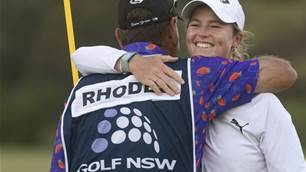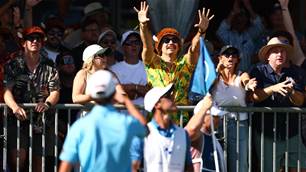Do you like poking fun at choking superstars? Give ShootOut Golf a try and be ready to crumble under the play-off pressure of your mates in the gallery.
Do you like poking fun at choking superstars? Give ShootOut Golf a try and be ready to crumble under the play-off pressure of your mates in the gallery.
 Scott Hookey tries to pretend there’s no one watching.
Scott Hookey tries to pretend there’s no one watching.Images: ShootOut Golf
As Bobby Jones once put it, there’s golf, and there’s tournament golf. To parse what the founder of the Masters really meant, there’s golf, and there’s golf when other people are watching you.Your correspondent shares one similarity with Jones – neither of us play, or played, golf for a living. There’s a Grand Slam’s worth of difference, though, between my contented bogey-plus weekends and the career of history’s greatest amateur, who despite possessing the purest of talent, was driven from the game at age 28. Too much pressure, he said, then went and volunteered to fight in World War II. If Jones couldn’t take it, the chances of the rest of us outside of Tiger Woods and Jack Nicklaus are nil. Even for good golfers – extending the definition of “good” to the guy winning your club’s Wednesday comp, to the talented kids in elite amateur events, to journeymen tour professionals filling leaderboards all over the world – the game becomes infinitely more difficult when a gallery’s scrutiny bears down on you. So it is that a collection of hardy golfing souls tee up at Terrey Hills Golf and Country Club in Sydney’s north. The event is called ShootOut Golf, and its core conceit is to combine an anyone’s-welcome handicap competition with the flavour of pro-style, late-Sunday afternoon, fourth-round pressure that is the most entertaining part of golf on TV. Handicap events are the staple of the club golfer’s experience, competitions in which players of varying skill level are balanced out by an assigned number of extra strokes (the worse you are, the more you get). Players carry around their handicap like a caste mark. The Brahmins at the very top are the scratch players, who are expected to play the golf course much like the pros do, against par. Next rung down are the single digit players, so termed because their handicaps are lower than ten. These single-figures possess a degree of skill and seriousness about their game, and one is usually way out of proportion to the other.
The most general handicap is 18, an added shot for every hole. In a triumph of mediocrity, an 18-marker most commonly takes home first prize in a handicap event for a simple reason: they make up the majority of most fields. But then there’s the real game within the game of golf – those players who manipulate their handicap to keep it artificially high, above a proper measure of their ability. In self-regulating golf, where you call penalties on yourself, these scoundrels have a special scorn reserved for them. In the United States they’re known as sandbaggers. In Australia they’re called burglars.Veterans of handicap comps know the drill: head out for 18 holes with three other people, play variously well or not, return to the clubhouse for a drink and the result, then grouse about how the winner was playing off an advantageously inflated number of strokes. The strength of ShootOut’s format is the winner has to close out a victory on the course. “It’s far better than sitting in here and waiting,” says Chris Parkes, creator of the concept. “Everyone can see who wins.”How it works: at the end of the round, six of the 18 holes are randomly drawn. Instead of a score for a full round, the players in the field add up a total for those half-dozen holes. The top eight totals advance to a four-hole, elimination play-off, while the rest of the field congregates to toast the good fortune of their fellow competitors with harrowing pressure.Like a poker game, it doesn’t matter how well you play throughout the night, only that you cash in on the big hands. Score well on the selected holes and a player in the middle of the pack can find himself in the play-off, while a finisher in the top five misses out.
Related Articles

Lightning and low rounds at NSW Women’s Open

"More pointless than Pokémon": Tomorrow's Golf League critiqued, and roughly













